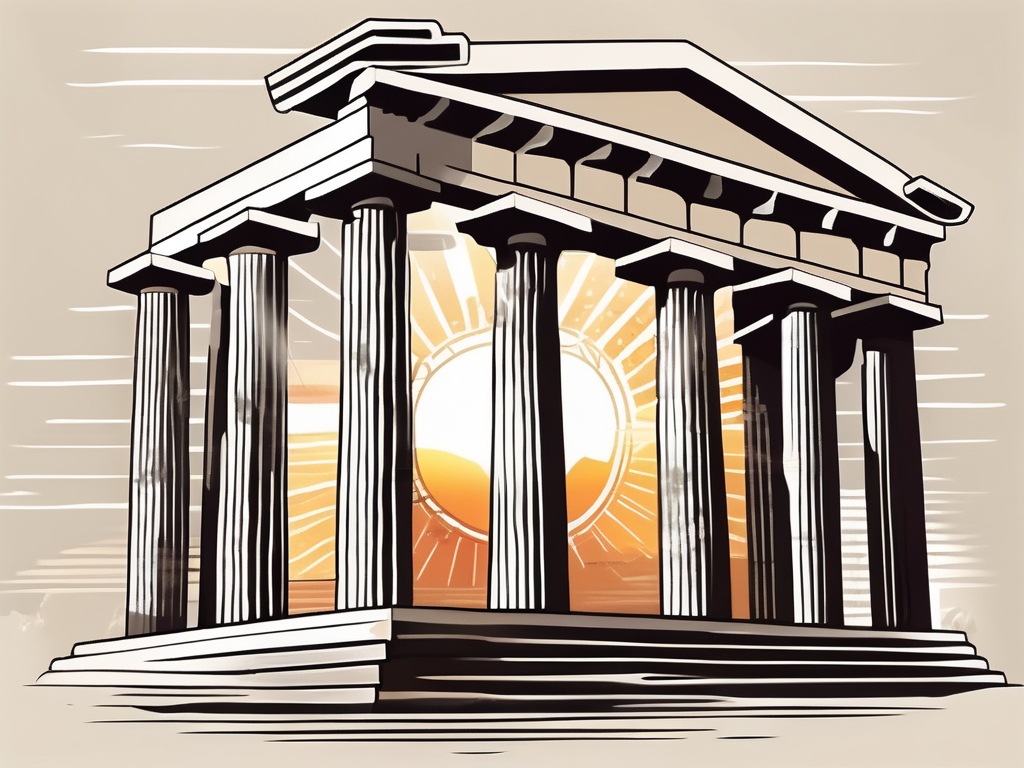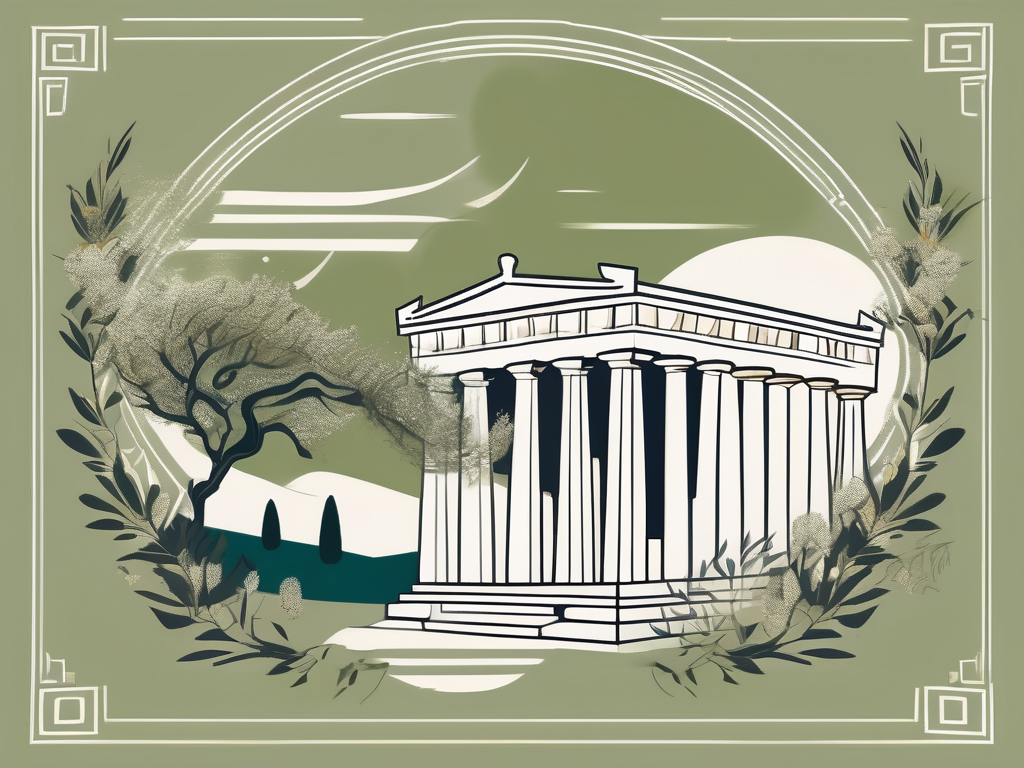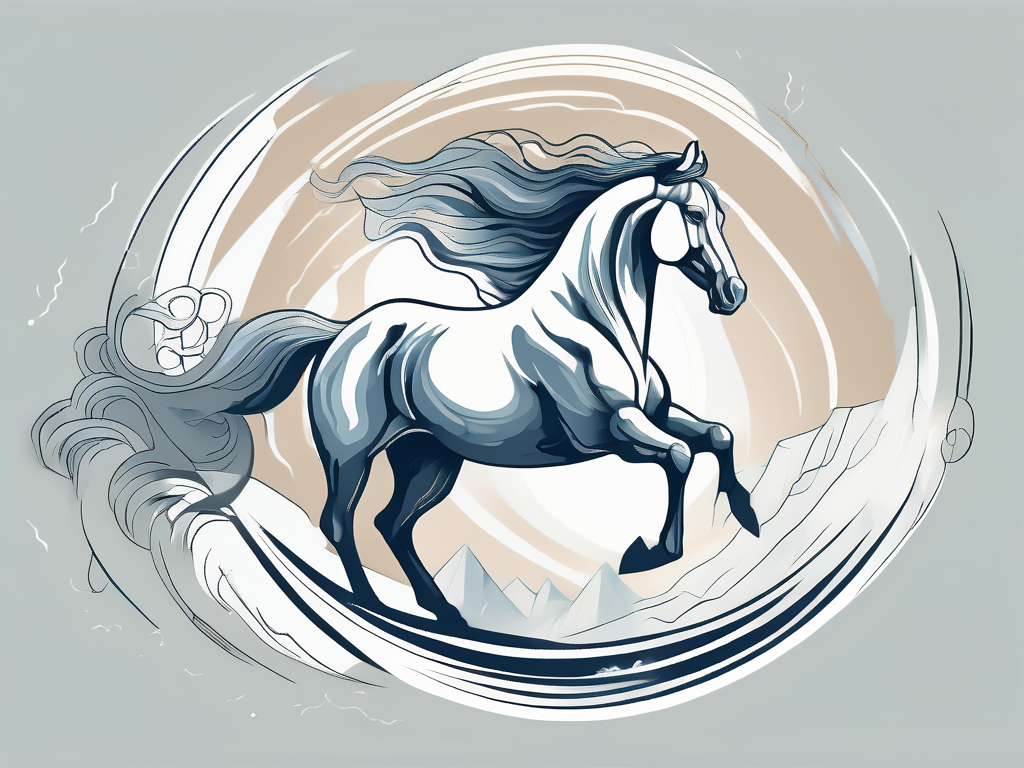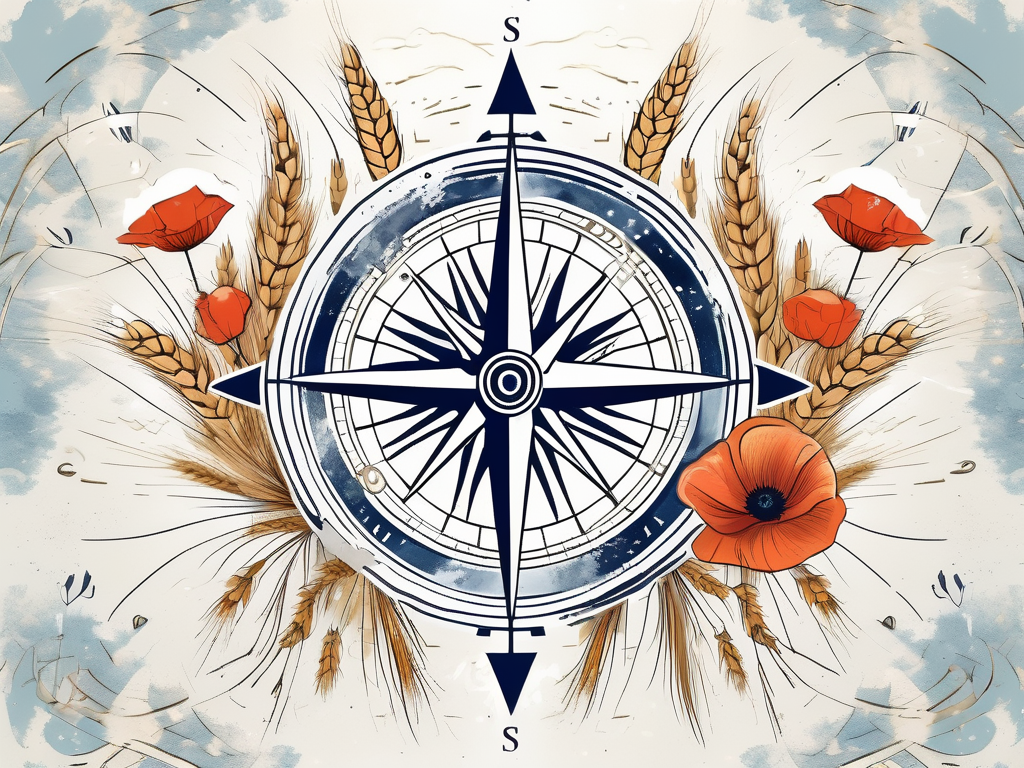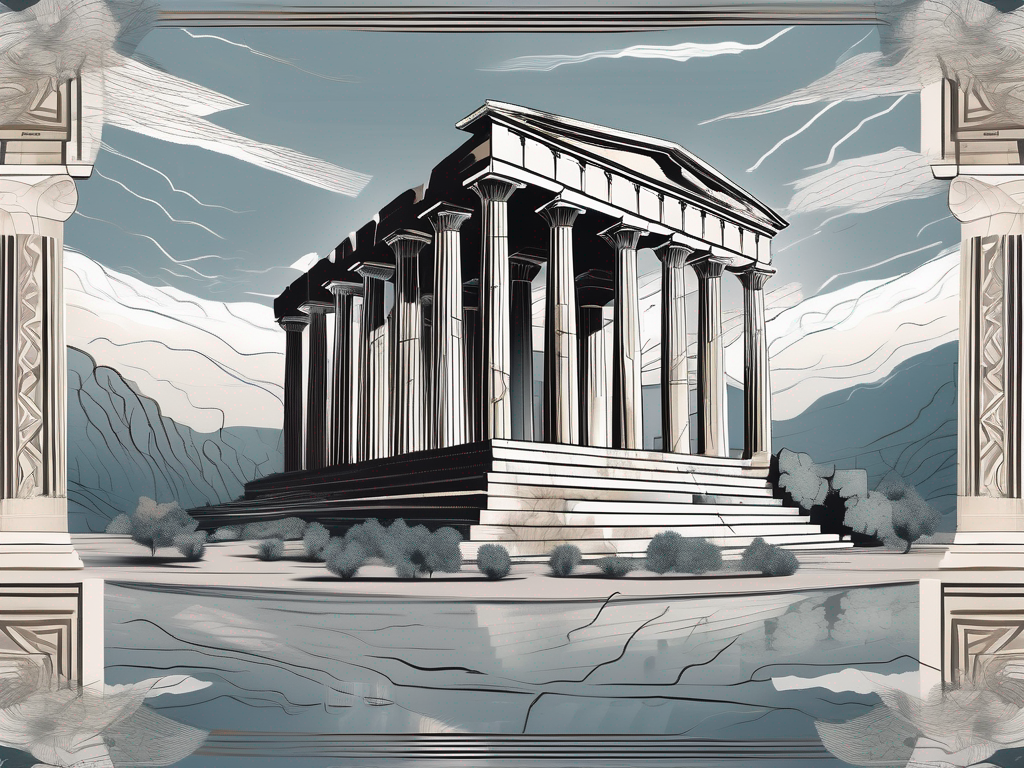Greek mythology is replete with a captivating array of gods and goddesses, each with their own unique powers and characteristics. One such deity that often gets overlooked is Eurus, the enigmatic Greek god of the east. In this article, we will delve into the various aspects of Eurus’ mythology, symbolism, ancient depictions, rituals, and his influence on modern culture.
Understanding the Role of Eurus in Greek Mythology
Eurus, also known as Euronotus, was considered one of the four Anemoi, the gods of the winds in Greek mythology. While his more prominent siblings, Boreas, Zephyrus, and Notus, often steal the limelight, Eurus had a unique place among them.
Legend has it that Eurus was born to Astraeus, the god of dusk, and Eos, the goddess of the dawn. As the offspring of these two celestial beings, Eurus inherited the power to control the winds that blew from the east, shaping the weather and influencing the lives of mortals.
Eurus’ Place Among the Anemoi
Unlike his brothers, who represented the cardinal directions of north, west, and south, Eurus symbolized the easterly direction. This made him an essential deity in ancient Greece, where the winds carried both blessings and calamities.
The east wind, personified by Eurus, was believed to bring about a sense of renewal and rebirth. It was associated with the rising sun and the beginning of a new day. The gentle and warm breeze carried the promise of spring, rejuvenating the land and inspiring hope in the hearts of the people.
However, Eurus was not solely a harbinger of positivity. The east wind could also take a sinister form, bringing destructive storms and hurricanes that wreaked havoc in its path. This duality in Eurus’ nature made him a deity to be both revered and feared.
Eurus and the Concept of the East Wind
The east wind, associated with Eurus, held a significant place in ancient Greek culture. It was often portrayed as a gentle and warm breeze, signifying the arrival of spring and the fertility it brought. However, the east wind could also take a sinister form, bringing destructive storms and hurricanes that wreaked havoc in its path.
Throughout Greek literature and art, the east wind was depicted in various forms. In some myths, Eurus was described as a youthful and handsome god, with golden hair flowing in the wind. He was often shown carrying a cornucopia, symbolizing abundance and prosperity.
On the other hand, when the east wind turned fierce, it was portrayed as a tempestuous force, capable of uprooting trees and causing massive destruction. Sailors feared the wrath of Eurus, knowing that his storms could easily capsize their ships and send them to a watery grave.
Despite the potential dangers associated with Eurus, the ancient Greeks recognized the importance of balance in nature. They understood that the east wind, like all the other winds, played a crucial role in maintaining the harmony of the world. Without Eurus, the cycle of seasons would be disrupted, and life as they knew it would be forever altered.
The Symbolism of Eurus
As a deity with dualistic qualities, Eurus embodied the concept of change and transformation. He was closely associated with the shifting seasons, particularly autumn.
Eurus, the enigmatic deity, stood as a powerful symbol of the ever-changing nature of existence. His presence was felt in the gentle breeze that whispered through the trees, carrying the promise of transformation. Just as the wind rustled the leaves, Eurus stirred the hearts of mortals, urging them to embrace the inevitable changes that life brings.
Eurus as a Harbinger of Change
Eurus’ connection to autumn made him a symbol of change and transition. Just as the leaves turn from vibrant greens to warm hues, Eurus represented the inevitability of change in the natural world and in human life.
When Eurus blew his winds, the world took notice. It was a call to action, a reminder that stagnation leads to decay. Through his divine influence, Eurus encouraged mortals to shed their old ways and embrace the transformative power of change. Like the leaves that gracefully fall from the trees, Eurus taught that letting go of the past is essential for growth and renewal.
Eurus and the Season of Autumn
During autumn, the east wind carried whispers of impending winter, serving as a gentle reminder to prepare for the cold months ahead. Eurus symbolized the necessity to embrace change, shed what is no longer needed, and adapt to the cyclical nature of life.
As the days grew shorter and the air turned crisp, Eurus guided mortals through the transition from the warm embrace of summer to the chilly embrace of winter. His winds carried the scent of fallen leaves and the promise of new beginnings. Eurus reminded all who listened that change is not to be feared, but rather embraced as an opportunity for growth and transformation.
Just as the autumn leaves danced in the wind, Eurus encouraged mortals to dance with the rhythm of life, to let go of the old and welcome the new. Through his divine presence, Eurus taught that change is not a force to be resisted, but a force to be embraced, for it is through change that we discover our true potential.
Eurus in Ancient Greek Literature
Eurus found his place of prominence in ancient Greek literature, where he was often mentioned in various works by renowned authors like Homer and Hesiod.
As one delves into the rich tapestry of ancient Greek literature, the figure of Eurus emerges as a captivating character, woven seamlessly into the narratives of celebrated poets and storytellers. His presence, like a gentle breeze that stirs the imagination, leaves an indelible mark on the literary landscape of ancient Greece.
Eurus’ Depictions in Homer’s Works
Homer, the celebrated poet, referred to Eurus in both the Iliad and the Odyssey. In these epic tales, Eurus was depicted as a formidable deity capable of wielding his power in support of his allies or as a force to be reckoned with by his adversaries.
In the Iliad, Eurus is portrayed as a divine ally of the Greeks, lending his strength to their cause. His presence on the battlefield is described with awe-inspiring detail, as his gusts of wind propel the Greek warriors forward, imbuing them with a sense of invincibility. The mere mention of his name evokes a sense of reverence among the warriors, for they know that Eurus is on their side, guiding them towards victory.
Similarly, in the Odyssey, Eurus assumes a different role, one of a formidable obstacle in the hero’s journey. As Odysseus faces the challenges of his long and treacherous voyage, Eurus manifests as a fierce tempest, threatening to engulf the hero and his crew. The howling winds and tumultuous waves serve as a testament to Eurus’ power, reminding mortals of the unpredictable nature of the divine.
Eurus in Hesiod’s Theogony
In Hesiod’s Theogony, Eurus was recognized as the son of the Titans Astraeus and Eos. This divine lineage further added to his importance in Greek mythology and solidified his role as a powerful deity.
Hesiod’s Theogony delves into the intricate genealogy of the gods, unraveling the complex relationships that define the divine pantheon. Eurus, born of the union between Astraeus, the Titan of the dusk, and Eos, the goddess of the dawn, inherits the celestial powers of his parents. This divine heritage bestows upon him the ability to shape the winds and control their direction, making him a deity of great influence and significance.
As the offspring of two prominent Titans, Eurus occupies a unique position within the divine hierarchy. His presence serves as a bridge between the realms of day and night, symbolizing the cyclical nature of existence. Eurus’ role as a mediator between light and darkness further enhances his mythological stature, elevating him to the ranks of the most revered and respected gods.
The Worship and Cult of Eurus
While Eurus may not have been as widely worshipped as some of the other gods in ancient Greece, he did have a dedicated following who built temples and held rituals in his honor.
Temples and Sacred Sites Dedicated to Eurus
Temples dedicated to Eurus were primarily located in regions where the east wind had a significant impact. These sacred sites served as places of worship and pilgrimage for those seeking the blessings or protection of this enigmatic god.
Rituals and Festivals Honoring Eurus
Rituals and festivals dedicated to Eurus involved both celebration and veneration. These events often included the lighting of incense, offerings of food and drink, and prayers for a bountiful harvest and safe travels.
Eurus’ Influence on Modern Culture
While Eurus may be less well-known outside academic circles, his influence can still be felt in modern culture, particularly in literature and film, as well as in the symbolism associated with contemporary Greece.
Eurus in Contemporary Literature and Film
Eurus’ mystique and symbolic qualities have captured the imagination of modern authors and filmmakers alike. References to Eurus can be found in various works, where he is often portrayed as a complex character embodying change and transformation.
Eurus as a Symbol in Modern Greece
In modern Greece, Eurus continues to hold significance as a symbol of the eastern winds that still shape the country’s climate and landscape. He represents the iconic connection between the past and present, reminding the Greek people of their rich mythological heritage.
As we explore the enigmatic Greek god of the east, Eurus, we uncover a deity whose significance in Greek mythology extends far beyond his lesser-known status. From his relation to the Anemoi and the symbolism he embodies to his presence in ancient literature, worship, and impact on modern culture, Eurus offers a captivating figure ripe for exploration and understanding. So, let us embrace the winds of change and delve into the depths of Eurus’ mysteries.
